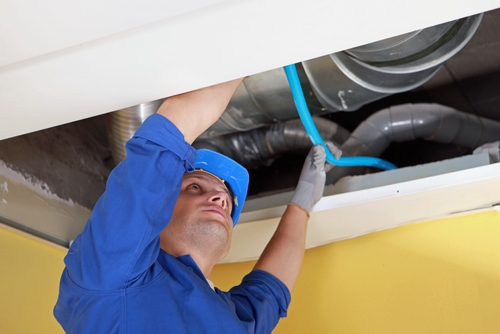Duct, Duct, Loose: 4 Factors Preventing HVAC Tape From Performing well

Residential and commercial heating, ventilation and air conditioning systems provide comfort to the families and businesses they serve, but they can only perform well if their ductwork has an airtight envelope. Without a consummate seal throughout the entire duct network, owners end up spending more on energy and risk compromising their indoor air quality, as well as the entire HVAC system.
Perhaps the only thing worse than perforated air ducts is believing recently serviced ducts work when they really don’t. How could that be? Isn’t sealing ducts with HVAC tape a pretty straightforward endeavor? You’re not wrong, but a lot of issues can arise if people applying HVAC tape aren’t savvy to the adverse environment conditions preventing that desired seal.
1. Temperature
Rising and falling temperatures are unavoidable in the world of HVAC systems. As heat or air conditioning disperses through ductwork, the sheet metal will respond naturally to temperature changes, warming or cooling accordingly. Not every tape product on the market retains its adhesion in hot or cold environments, let alone in places where temperatures fluctuate from one extreme to the other. Additionally, the insulated crawl spaces where ductwork typically winds may exacerbate external conditions that cause HVAC tape to lose its necessary seal.
2. Moisture
On the other hand, homes with less-than-adequate insulation may accidentally cause ductwork to “sweat,” or create water vapor and moisture. Duct sweat comes with its own list of problems: damaged wooden construction, mold creation, etc. If a home’s HVAC tape doesn’t have the ability to withstand moisture, add leaky ducts to the list. Like temperature, moisture also compromises adhesion.
“Are you sticking your HVAC tape to ducts or the layer of dust resting on your ducts?”
3. Debris
If you know one thing about tape, it’s this: It sticks to whatever you stick it to. The question is, are you sticking your HVAC tape to ducts or the layer of dust resting on your ducts?
In older houses or unfinished areas of the home, dust and other kinds of debris may collect on or around ducts. If these systems don’t receive a thorough cleaning before homeowners or contractors apply HVAC tape, the adhesion will grip the grit and not the duct itself, jeopardizing its efficacy before homeowners have had a chance to enjoy ductwork with a tight envelope.
Furthermore, without a user-friendly application process, HVAC tape adhesion could also be exposed to debris floating in the air, latching onto the tape and reducing its tack. Channeling and tunneling created during the application processes as well may allow for all sorts of contaminants to dig their way between HVAC tape and ductwork.
4. Wrong tape model
Don’t let the name fool you – traditional “duct tape” won’t cut it. Most brands of duct tape don’t adhere well enough to the galvanized sheet metal ducts are made out of, nor can they stand up against the other environmental conditions we’ve listed here today. Products like FlexSeal professional-grade metallized and cloth tape products, however, offer high levels of adhesion and tensile strength designed with sheet metal applications and temperature in mind.
Why overspend on a deficient residential or commercial HVAC system season after season, year after year? Invest in high-quality HVAC tapes that can take a beating and keep on heating.


